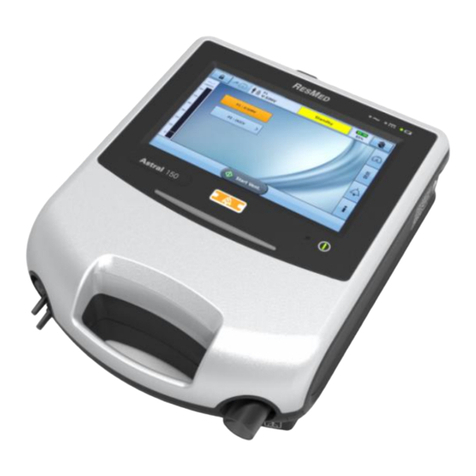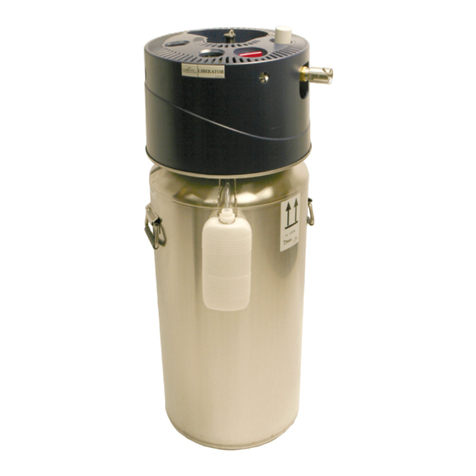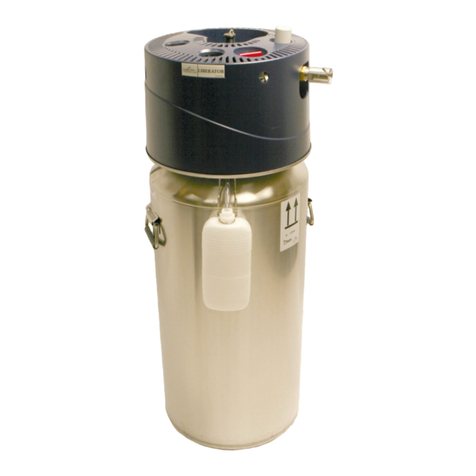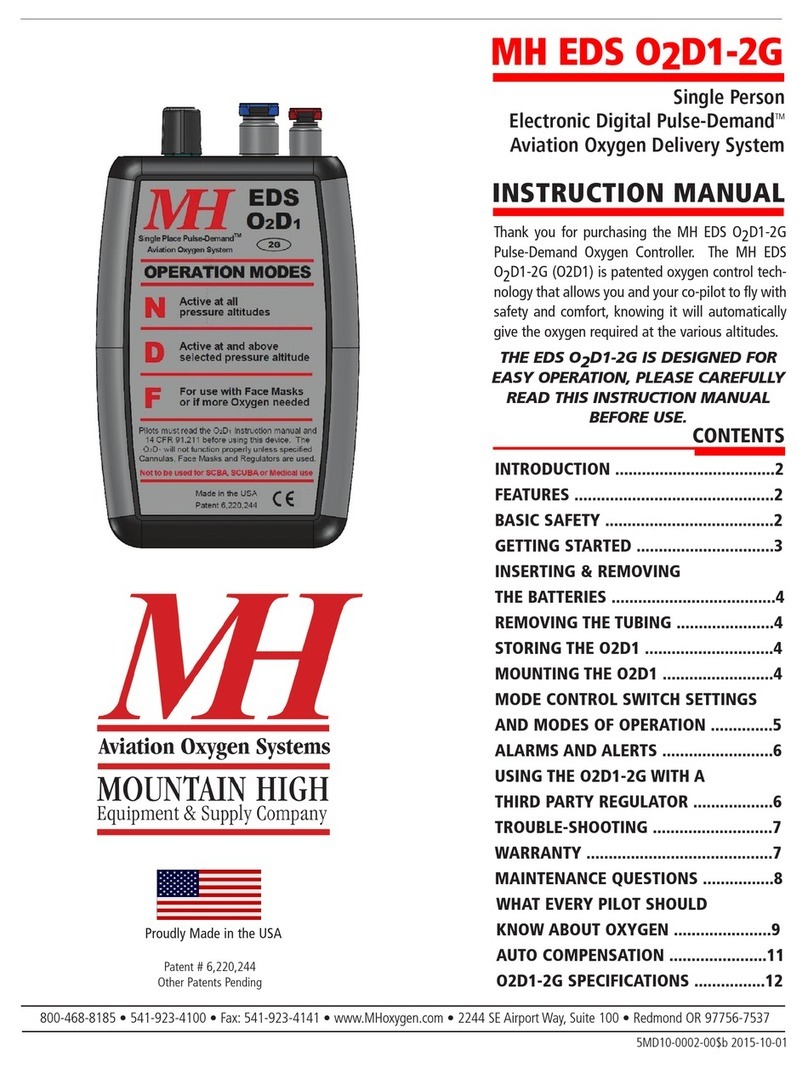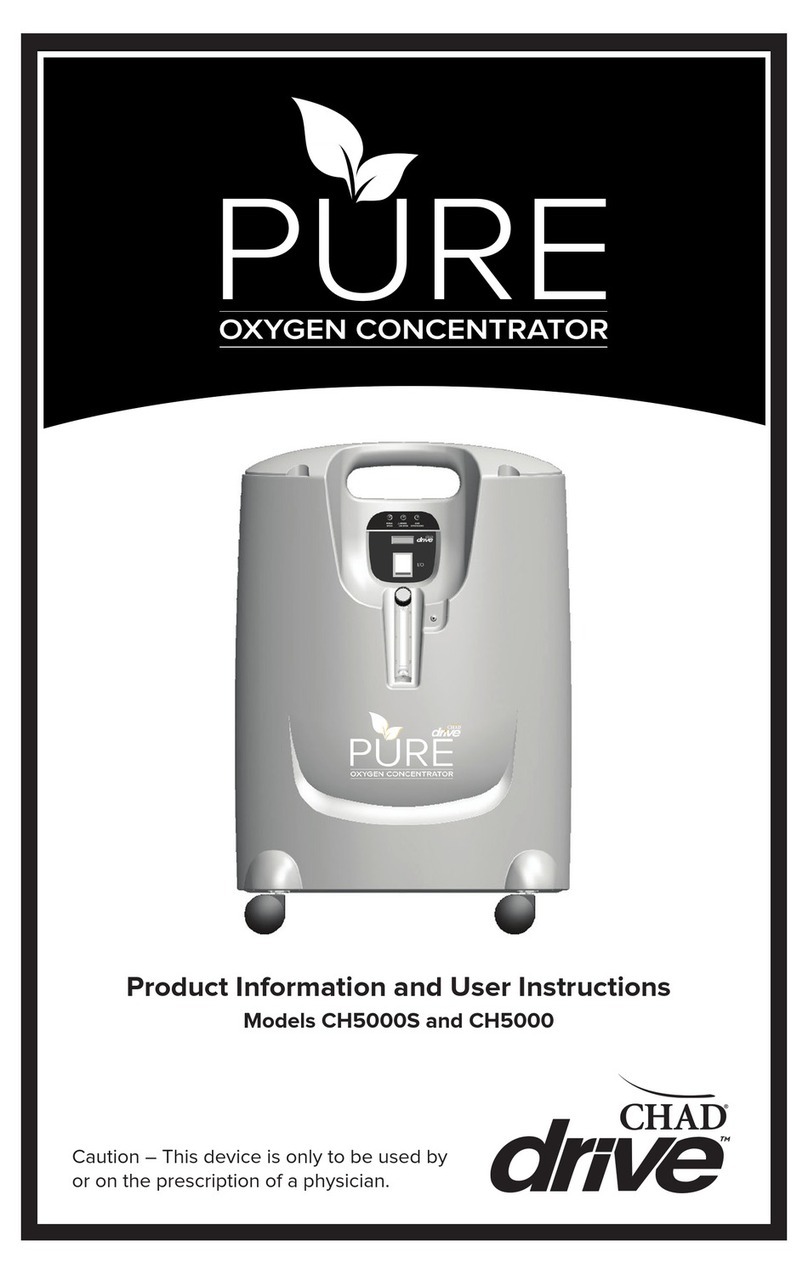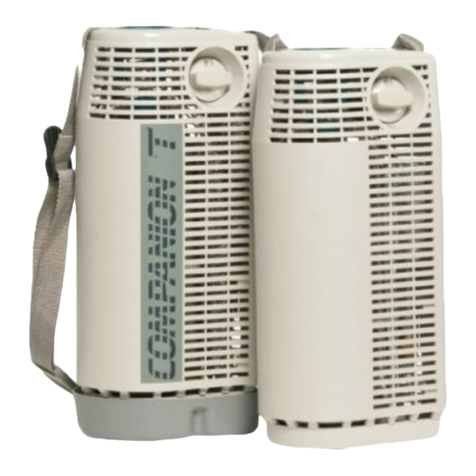Aerox Sky-Ox User manual

Aerox®Aviation Oxygen Systems, LLC
12871 Trade Way Drive, Suite 8
Bonita Springs, FL 34135
www.aerox.com
Page 2
Thank You
ThankyouforinvestinginaSky-Ox®PortableSystemfromAerox Aviation
Oxygen Systems. Your Portable Oxygen System, includingthe Click &
Breath™regulatorintroducedin2008,is designed,engineered, and
manufactured to the highest quality standards in the industry and we
are committed to serving your needs with equally high customer
service.
Table of Contents
Page Subject Content
3 ................... System Components
4 ................... Operating Instructions
7 ................... Refilling the Aluminum Cylinder
8 ................... Refilling the Steel Cylinder
9 ................... After Using the System
10 ................... Oxygen Cylinder Maintenance
13.................... Care of Your Portable Oxygen System
13 ................. Care of Your Oxygen Cannula
14 ................. Table 1: Capacity Table
14 ................. Table 2: Volume Content Table
REGISTER YOUR SYSTEM
Registering your purchase will help us keep you up to date on product
information and will activate your warranty. To register your product
within 60 days of purchase please go visit us at:
https://www.aerox.com/warranty/

Aerox®Aviation Oxygen Systems, LLC
12871 Trade Way Drive, Suite 8
Bonita Springs, FL 34135
www.aerox.com
Page 3
System Components
The cylinder contains high pressure oxygen - a strong oxidizing
agent and improper use of Oxygen Breathing Equipment can be
dangerous!
Do not use this device until you are familiar with its proper
operations. Do not smoke! Keep away from open flame, oil,
grease, or other combustibles that could contribute to violent
combustive action. Use in well-ventilated area.
Cylinder contains high pressure (up to 2,000 pounds per square
inch- psi) oxygen. Do not drop and protect the unit from shock or
damage. Keep away from anyone who may not be familiar with
the hazards of its improper use or handling.
Maintain equipment using an Aerox-Approved FAA Authorized
Aviation Oxygen Repair Station. Follow their recommendations
on proper use.
(7) Flow Adjustment Control For
setting altitude or flow setting.
Do Not use as a shut off
valve.
(6) Quick Disconnect Port for
Cannula or Mask
(5) Regulator
Available with 2-port or 4 port receptors
(4) Hand Tightening Grip
(3) On/Off Valve
(2) Cylinder Content Gauge
(1) Pressurized Cylinder or Tank
!
DANGER
!

Aerox®Aviation Oxygen Systems, LLC
12871 Trade Way Drive, Suite 8
Bonita Springs, FL 34135
www.aerox.com
Page 4
Operating Instructions
Referring to the illustration above, the Sky-Ox® portable
oxygen system includes the following components:
•a cylinder (1) with an On/Off Valve (3)
•a cylinder pressure gauge (2)
•Click-a-Breath Regulator (5) with either a 2-port
or 4- port Quick Disconnect female receptor (6)
that will accept a male fitting of a cannula or
mask in each port.
Sky-Ox®Portable Oxygen Systems are shipped with two or four pendent style
Oxysaver® Cannulas (see photo) and one mask. Each Sky-Ox® cannula comes
complete and assembled with a connector, flow-indicator, and pendant cannula.
The pendent style offers more freedom plus comfort and the ability to drink water,
coffee, a can of soda, or to eat a sandwich .
The size of cylinder you specified is based on projected flight hours of use. Based
on your order, the cylinder arrives either filled with oxygen or empty . If empty, the
cylinder must be filled with aviator-grade oxygen before using.
Ready to Use: Filled Cylinders are ready to use.
1.
Turn the On-Off Valve (3) counterclockwise until fully on. Turn clockwise to
shut it off.
2.
Check the cylinder’s content level on the cylinder Pressure gauge (2). This
gauge will indicate how much oxygen remains in the cylinder. If the indicator
needle is in the red area, the cylinder is getting very low on oxygen. If the
indicator needle is all the way to 2,000 psi, the cylinder is full. (All cylinders
filled with 2000 psi) . Do not over pressurize the cylinder.
3.
Activate the oxygen flow with the regulator’s Flow Adjustment Control knob
(7) by turning it clockwise. You will hear it click between precise oxygen flow
settings from .3 LPM to 5.0 LPM (see table or on the Regulator’s body).
4.
Insert the quick disconnect element onthe mask or cannula into
anopenport(6)
ontheregulatorhead.Oxygenwillnotflow
untilthefitting onthebreathing
devicesaresecurely connected.
Theoxygenflowwillstopwhenthecannula
ormaskisdisconnectedfromtheport.Itdoesnotmatterwhetherone,two,
three orfourcannulaareconnectedbecauseonlythoseconnected
will
dispenseoxygen.

Aerox®Aviation Oxygen Systems, LLC
12871 Trade Way Drive, Suite 8
Bonita Springs, FL 34135
www.aerox.com
Page 5
5.
Ifyouareusing the Oxysaver®
Cannula, set it to
the flow rate indicatedonthe
Regulator.
Note:
For simplicity, it is recommended that the flow indicator be set at (0.5 liters
per minute) for altitudes up to 15,000 feet. If you are flying at a lower
altitude, you can adjust it downward if desired –always verify your blood
oxygen saturation (SpO2) with a pulse oximeter.
You do not need to adjust the Regulator when multiple ports are being used.
The regulator automatically compensates when additional (1-2-or 3)
breathing units are attached. A setting of (0.5) liters per minute will deliver
0.5 liters of oxygen from each port.
The following table is
found on the Regulator
Liters per minute when using
Oxysaver®Cannula
Mask
.3 LPM up to 10,000 FT.
1.0 LPM up to 10,000 FT.
.4 LPM - 12,000 FT.
1.5 LPM - 15,000 FT.
.5 LPM - 15,000 FT.
2.0 LPM - 20,000 FT.
.6 LPM - 18,000 FT.
2.5 LPM - 25,000 FT.
Altitude Gauge Settings
When Using The Oxysaver®
Cannula
Up to 10,000 feet
.3 Liters / minute
Up to 12,000 feet
.4 Liters / minute
Up to 15,000 feet
.5 Liters / minute
At 18,000 feet
.6 Liters / minute
Note: FAA recommends 1.8 Liters at 18,000
feet when using a mask or regular
cannula.

Aerox®Aviation Oxygen Systems, LLC
12871 Trade Way Drive, Suite 8
Bonita Springs, FL 34135
www.aerox.com
Page 6
6.
A flow indicator is located in line with the cannula. Iftheindicatorisred, thereis
nooxygenflowing.Ifthe indicatorisgreen,itindicatesthat
oxygenisflowingfrom
thecylinder to the cannula.
Sky-Ox® Flow Indicator (showing no-oxygen flow)
7.
Acannula(eitherapendentoramustachestyle)canbeused onlyupto18,000ft.
Above18,000ft.,youmustswitchoverto
amask.
8.
Whenusingthemask,settheflowadjustmentcontroltothe
altitude you are flying.
(See table on Regulator - also printed on
page5.) ByturningtheFlowAdjustment
Control(7)knobon top of the Regulator until the indicator number is properly
positioned.
Liters Per Minute indicator number readout on Regulator

Aerox®Aviation Oxygen Systems, LLC
12871 Trade Way Drive, Suite 8
Bonita Springs, FL 34135
www.aerox.com
Page 7
Refilling the Aluminum Cylinder
Do not use any tools –all fittings should be hand-tight. Always turn off the system
before proceeding with refilling the cylinder. Completely close the On/Off Valve (3)
before attempting to disconnect the regulator
Do Not Remove the On/Off Valve (3).
Remove the Regulator (5) from the valve by loosening the green Hand-Tightening
Grip (4) (see figure below) between the On/Off Valve and the Regulator. (Turn Grip
Counterclockwise. The valve is a standard fitting for oxygen (CGA 540) and no
tools are required.
Aerox recommends using only aviator grade oxygen. The oxygen supplier is
responsible for testing their storage and charging systems.

Aerox®Aviation Oxygen Systems, LLC
12871 Trade Way Drive, Suite 8
Bonita Springs, FL 34135
www.aerox.com
Page 8
To fill Aluminum Portable Cylinders
A standard oxygen filler line or pigtail is attached to the valve opening and the
On/Off Valve is opened for charging. Whenfully charged, the On/Off Valve (3) is
closed and the charging line disconnected.
When filling the cylinder, the oxygen supplier will inspect your cylinder and, if
needed, will hydrostatically test the unit. Note: Aluminum cylinder must be
hydrostatically tested every five years and steel cylinders every five years. The
oxygen supplier will label each cylinder when it is hydrostatically tested.
After cylinder is refilled, make sure the regulator assembly is reattached to the
cylinder valve and tighten securely with Hand Tightening Grip (4) - No wrench is
needed.
Refilling the Steel Cylinder
Use the same procedures for refilling steel cylinders asfor aluminum cylinders. See
above illustration for the location of On/Off Valve (3). To remove the Regulator for
refilling, loosen the hand tightening grip (4) between the On/Off Valve(3) and the
Regulator (5). The grip is located to the left of the On/Off Valve in the above
illustration.After refilling, make sure this Regulator (5) is securely fastened - hand
tightening (4) only needed. - No wrench is needed.

Aerox®Aviation Oxygen Systems, LLC
12871 Trade Way Drive, Suite 8
Bonita Springs, FL 34135
www.aerox.com
Page 9
After Using System
1. When finished using the Sky-Ox® portable oxygen system, turn the Flow
Adjustment Control ( 7 ) to zero (0).
2. Turn the On/Off Valve (3) off by turning the knob clockwise.
3. If you have removed all of the quick disconnect units, reinsert one to bleed-
off the oxygen still in the line. The flow indicator turns to red when no more
oxygen is flowing.
4. When the system will be inactive for more than 24 hours, it is recommended
that the system be shut down as described above.

Aerox®Aviation Oxygen Systems, LLC
12871 Trade Way Drive, Suite 8
Bonita Springs, FL 34135
www.aerox.com
Page 10
Oxygen Cylinder Maintenance
Initial Filling
Charge the oxygen cylinder as follows;
Slowly pressurize the cylinder to the rated regulator pressure. Do not exceed the
cylinders rated pressure.
Note: To prevent over heating, caused by compression, it is recommended that
filling be accomplished in stages as shown in Table 1. Each stage should take no
less than 3 minutes to accomplish with a 2 minute rest between each stage.
Stage
PSI
1
500
2
1000
3
1500
4
1800
5
2000
6
2250
TABLE 1
CAUTION
Keep Hands and Filling Equipment Clean And Free From Oil. Keep Away
From Flame Or Sources Of Ignition. Failure To Comply With All Cautions
Could Result In Injury And Death.
Routine Maintenance
•It is important to maintain positive pressure in oxygen cylinders at all
times.
•Do not allow the cylinder pressure to fall below 50 PSI if possible.
•A fully depleted oxygen cylinder may require a dry air or nitrogen
purge to remove moisture.
•Table 2 Provides Hydrostatic Test and Service Life
requirements for listed cylinders.

Aerox®Aviation Oxygen Systems, LLC
12871 Trade Way Drive, Suite 8
Bonita Springs, FL 34135
www.aerox.com
Page 11
Cylinder
Type
Hydrostatic Test &
Inspection Rqmt
Maximum
Service Life
DOT 3AL
Every 5 Years
Unlimited
6061T6 Alum
49 CFR § 180.209
DOT 3HT
Every 3 Years
24 Years
Steel
49 CFR § 180.209
DOT-E 8162
Every 5 Years
15 Years
Kevlar/Comp
49 CFR § 180.209
(10,000 Cycles)
DOT-E 10945
Every 5 Years
15 Years
Carbon/Comp
49 CFR § 180.209
(10,000 Cycles)
Cylinder Purge
Cylinder pressures below 50 PSI may allow air into the cylinder. Air contains
moisture and under certain temperature extremes can freeze and plug oxygen
ports and lines.
The most effective method to purge the cylinder of any suspected moisture is to
remove the regulator/valve and with the cylinder turned so the threads are
down, blow hot air (heat gun or hair dryer) into the cylinder for about 20 minutes
or until all moisture has evaporated.
Where a cylinder has been exposed to an extended period of low storage
pressure, a cleaning and inspection by a licensed maintenance facility is
recommended.
Re-Filling
Verify the condition and cleanliness of all ports and fittings prior to performing
re-filling operations.
When re-installing the regulator or valve, assure that the proper approved o-
ring or seal has been installed.
Charge the oxygen cylinder as discussed in Initial Filling.
Upon completion of filling operations, check for leakage using a liquid leak
detector or a mild soapy water formula.

Aerox®Aviation Oxygen Systems, LLC
12871 Trade Way Drive, Suite 8
Bonita Springs, FL 34135
www.aerox.com
Page 12
General
Fill only with Gaseous Aviators Breathing Oxygen, per MIL- PRF-27210.
Note that certain state, federal and international regulations may apply to the
handling and maintenance of oxygen cylinders based on installation and
application.
Further information regarding oxygen cylinder maintenance and use is available
upon request.

Aerox®Aviation Oxygen Systems, LLC
12871 Trade Way Drive, Suite 8
Bonita Springs, FL 34135
www.aerox.com
Page 13
Care of Your Portable Oxygen System
•If the temperature in the plane is expected to rise above 130oF, remove the
cylinder from the aircraft when not in use. (A padded carrying bag for your
system is available as an option —below.)
•If the temperature falls to, or expected to drop to minus 25oF, it is advisable
to remove the cylinder from the plane.
•Note padded carrying bag can be used to help secure the cylinder inside
the plane. Place both straps of the carrying bag around the seat and secure
tightly. The portable oxygen system will operate properly in either an upright
or a horizontal position.
•Always secure and restrain your system as a precaution should in- flight
turbulence be experienced.
Reminder: The system is under 2000 PSI of pressure when full. As a safety
measure, the regulator is equipped with a pressure relief valve that’s
designed to activate under a reduced pressure rate to depressurize the
cylinder.
Care of Your Oxygen Cannula
Do Not bend, fold, or crimp the clear hoses of the cannula because they may
become cracked or damaged.
To clean your cannula after use, wipe with a soft cloth and a soft non-detergent
soap. Do Not Use alcohol which may damage the unit. DO NOT SUBMERGE
THE CANNULA.
Replacement of the cannula is recommended after 3 years or 200 hours of use.

Aerox®Aviation Oxygen Systems, LLC
12871 Trade Way Drive, Suite 8
Bonita Springs, FL 34135
www.aerox.com
Page 14
System Capacity Table
Table 1: This table provides valuable capacity information relating to the
Sky Ox Portable Oxygen Systems.
Model
Number
Oxymizer Cannula
Duration Hours
at 15,000 Ft.
Cylinder
Capacity
With Mask
Duration Hours
at 15,000 Ft.
Approx.
Size (H X D)
Approx.
Weight
SK 12-6
5:28 hrs.
6 CU. FT. AL
1:49 hrs.
18 -1/2" x 3-1/4"
6 Lbs.
SK 12-9
8:07 hrs.
9 CU. FT. AL
2:45 hrs.
18-0" x 4-3/8"
7 Lbs.
SK 12-15
13:48 hrs.
15 CU. FT. AL
4:36 hrs.
24-0"x 4-3/8"
11 Lbs.
SK 12-24
22:42 hrs.
24 CU. FT. AL
7:34 hrs.
32-1/2" x 4-3/8"
14 Lbs.
SK 11-20
17:33 hrs.
20 CU. FT. Steel
5:51 hrs.
17-0" x 5-1/4"
15 Lbs.
SK 11-40
39:27 hrs.
40 CU. FT. Steel
13:09 hrs.
21-0" x 7"
28 Lbs.
SK 11-50
46:21 hrs.
50 CU. FT. Steel
15:27 hrs.
26-0" x 7"
36 Lbs.
Volume Content Table
Table 2: Content volume of oxygen in each cylinder when filled to capacity at 2000 psi.
Oxygen Content By System
Model When Full (2000 psi)
Model Number
Liters
SK-11-50
1415
SK-11-40
1132
SK-12-24
682
SK-11-20
566
SK-12-15
415
SK-12-9
248
SK-12-6
164

Aerox®Aviation Oxygen Systems, LLC
12871 Trade Way Drive, Suite 8
Bonita Springs, FL 34135
www.aerox.com
Page 15
For more information on Sky-Ox Products, visit us at www.aerox.com/sky-ox/
Oxysaver®, Aerox®, Sky-Ox®, and Click-a-Breath® are registered trademarks of Aerox Aviation
Oxygen Systems, LLC. © Aerox Aviation Oxygen Systems, LLC 2022
Table of contents
Other Aerox Oxygen Equipment manuals


